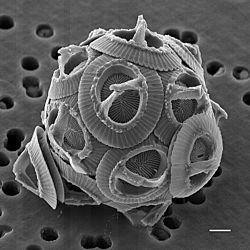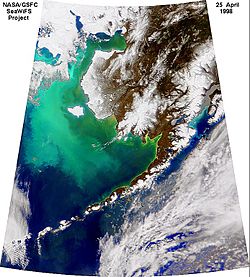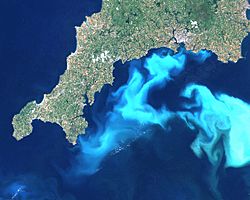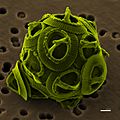Coccolith facts for kids
Quick facts for kids Coccolithaceae |
|
|---|---|
 |
|
| The coccolithophore Gephyrocapsa oceanica. | |
| Scientific classification | |
| Domain: | |
| Kingdom: | |
| Phylum: | |
| Class: |
Prymnesiophyceae
|
Coccoliths are tiny, microscopic algae that live in the ocean. They are so small you need a powerful microscope to see them! These amazing single-celled organisms are called coccolithophores or coccolithophorids. They create a special spherical shell around themselves called a coccosphere. This shell is made of tiny plates of calcium carbonate, which is the same material found in chalk.
Did you know that much of the chalk you see, like the famous White Cliffs of Dover, is made almost entirely of coccoliths? In fact, chalk from the Upper Cretaceous period (a long time ago!) is 95% to 99% coccoliths!
Scientists first looked at coccoliths a long time ago. Cristian Gottfried Ehrenberg (1795–1875) studied them, but he thought they were just non-living bits of rock. Later, Thomas Henry Huxley realized these tiny structures were made by living organisms. He also understood that they were a huge part of the rock we call chalk.
Coccolithophores play a big role in sending calcium and carbonate to the ocean floor. They are a major part of the carbonate found in deep-sea sediments. For example, in the Northeast Atlantic Ocean during the last ice age, coccoliths made up 70-80% of the total carbonate during warm periods. There were fewer of them during colder, glacial times.
Coccoliths first appeared at the end of the Triassic period, about 200 million years ago. It's interesting that another group of tiny algae, called diatoms, also appeared around the same time. Coccoliths were most common during the Cretaceous period. This was a time when there were many warm inland and continental shelf seas. Even today, they are very important for the ecology of our oceans and for understanding Earth's geology.
Emiliania huxleyi
Emiliania huxleyi (often called Ehux for short) is one of the most important tiny algae on Earth today. It is the most common coccolithophore found in the world's oceans. You can find lots of it in the northeast Atlantic Ocean, the northeast Pacific Ocean, and the eastern Mediterranean Sea.
Sometimes, huge groups of Ehux grow together. These are called gigantic algal blooms. They are so big that you can easily see them from satellites in space! This way of life, forming large blooms, started between 80,000 and 50,000 years ago. This time is known as the Ehux Acme zone in the fossil record.
Ehux is only found in relatively young sediments. This means it must have evolved fairly recently in Earth's history. Scientists use the first appearance of Ehux in sediment layers as a special marker. This helps them understand the age of different rock layers. This first appearance was dated to about 270,000 years ago. Later studies suggested it was around 242,000 to 268,000 years ago.
Images for kids
-
False-colour scanning electron micrograph of Gephyrocapsa oceanica, showing the coccoliths.






